Chesapeake Bay fishing is world-renowned for its quality, diversity, and scenic qualities, whether you're plugging for striped bass or trolling for bluefish. The Chesapeake is North America’s largest estuary, where salty waters of the Atlantic Ocean mix with the freshwater flow of rivers like the Susquehanna, the Potomac, and the Rappahannock. The resulting brackish stew is idea for species like striped bass, bluefish, speckled sea trout, red drum, and many, many more. We’ll discuss how to catch these fish in detail, but first, let’s get a glimpse of what some red-hot Chesapeake Bay fishing action looks like. This video was taken during an afternoon of fishing in March, in the middle Chesapeake Bay near Calvert Cliffs.
How do most people try fishing on Chesapeake Bay? The basic techniques include:
- Fishing with cut bait
- Fishing with live bait
- Chumming with ground fish or clams
- Trolling with lures
- Casting and retrieving lures
- Jigging with soft plastics or spoons
The fishing we saw in that video could be categorized as either casting and retrieving lures, or as jigging with soft plastics. There’s some overlap between these and many other types of Chesapeake Bay fishing — which take place for literally dozens of different species of fish. So let’s examine these forms of fishing on the Bay in their most basic terms.
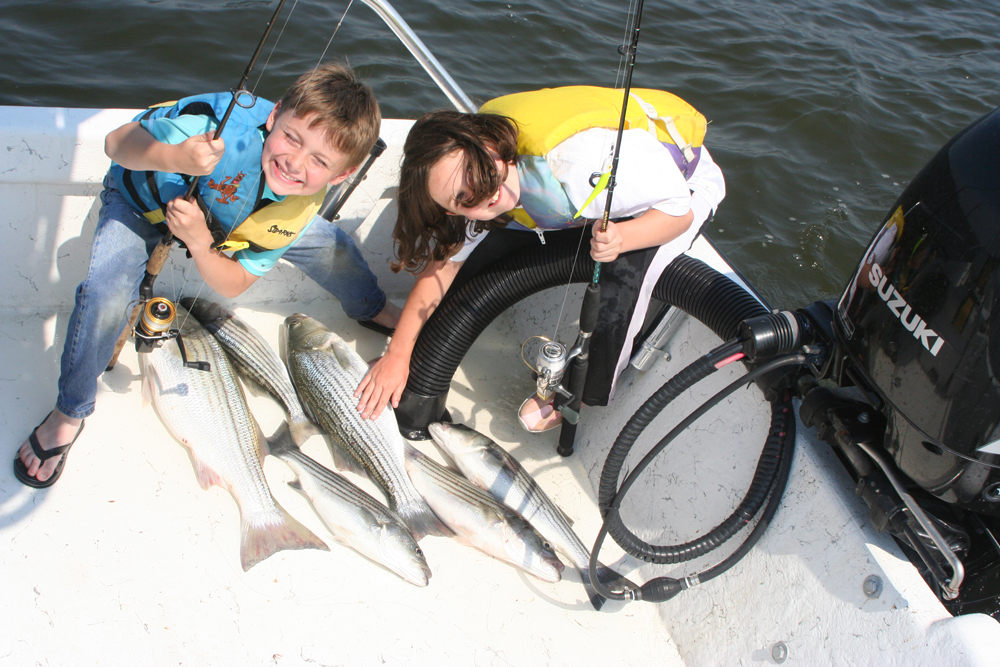
Fishing With Cut Bait
Chesapeake Bay fishing with cut bait can mean many things. It might be slicing bloodworms into little tidbits and threading them onto a top-and-bottom rig to catch panfish like spot, croaker, and white perch. It could mean cutting bunker (also known as menhaden) into chunks used to attract species like striped bass and bluefish. In the southern reaches of the Bay, where the water is saltier and more like the open ocean, it could refer to using cut strips of squid to catch fish like flounder and croaker. And at certain times of the year, cut bait may even be used to attract the attention of giant gamefish. Many anglers use cut soft crab, for example, to target black drum — which can grow in excess of 100 pounds.
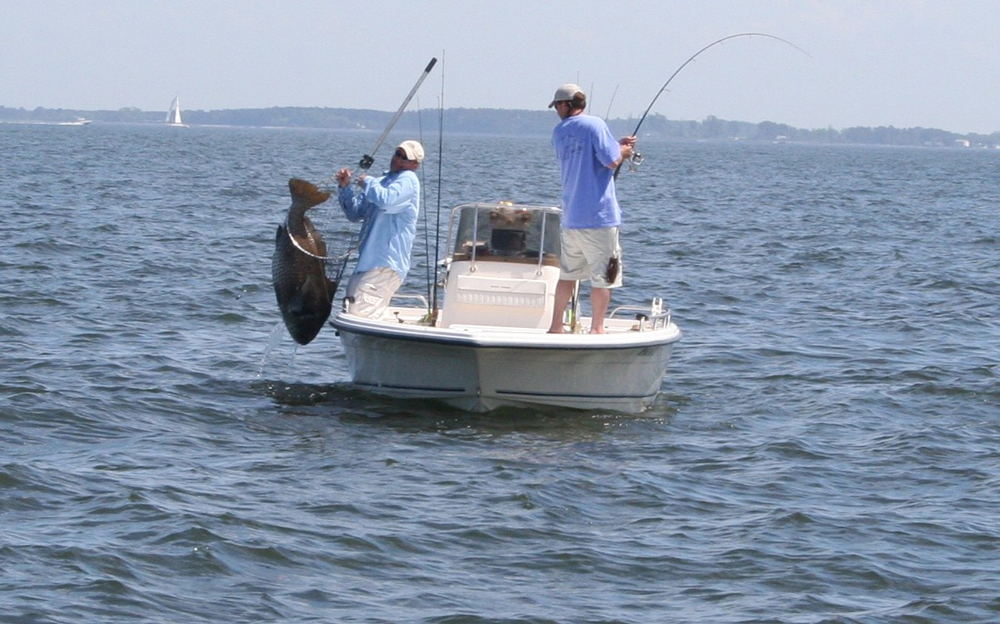
The one thing all forms of fishing with cut bait have in common? The angler is using pieces of a naturally-occurring food to get a predator fish on his or her line. Fishing with cut bait may be done while casting from the shoreline, while on a boat at anchor or adrift, and is also commonly used in conjunction with chumming (more on this later). Cut baits normally used on the Chesapeake Bay include:
- Bloodworms – used for panfish including spot, croaker, and perch, and on occasion, used for larger species such as striped bass or weakfish.
- Bunker (also called alwife or menhaden) –used for a very wide variety of larger predators including striped bass, bluefish, red drum, blue catfish, sharks, and cobia. Bunker are among the most abundant baitfish in the Bay, and just about all predators go after them.
- Grass shrimp – used to catch most panfish species.
- Herring – used for larger predators, often the same species as bunker.
- Mullet – also used for these same larger predators. Mullet are only present in large numbers in salty areas, so their use as a bait is generally limited to the southern reaches of the Chesapeake.
- Night crawlers – used in fresher areas of the Bay and its tributaries, for species like largemouth bass, bluegill, perch, and catfish.
- Razor, surf, and manninos clams – used for fish that commonly feed on bottom, including black drum and in some cases, striped bass.
- Soft crab and peeler crab – used for virtually any fish in the Chesapeake; just about everything that swims in the Bay likes to eat crab.
- Squid – used for species common to the saltier portions of the Chesapeake such as flounder or sea bass, as well as croaker, weakfish, and sometimes striped bass.
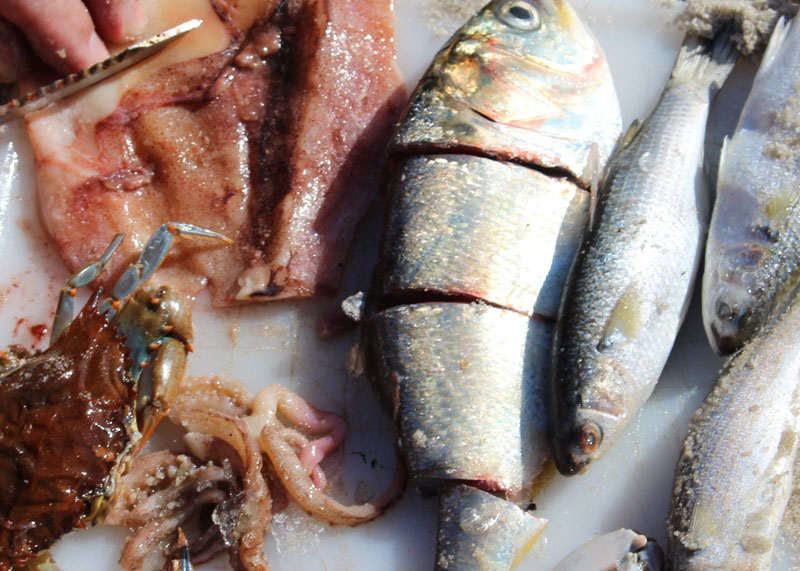
In many cases, such as when attempting to catch monster blue catfish, cut bait is simply cast out or dropped to the bottom and allowed to rest there until a fish finds it. In some other cases, such as when fishing for flounder, the bait is drifted or possibly even trolled at a very slow speed to attract a fish’s attention. And on occasion (fishing for triggerfish is one example) the cut bait may even be sight-cast right in front of a fish that the angler has spotted.
Since cut bait is very effective and is quite simple to use, many beginners start out by using it. Most of these baits are also readily available at the local tackle shops lining the Chesapeake’s shores. On the other hand, some people shy away from using cut bait because it can be very messy.
Fishing With Live Bait
Many of the live baits used by anglers who enjoy Chesapeake Bay fishing are the same as ones listed above — the anglers simply gather or buy them live, and keep them alive until they go on the hook. The list of commonly used live baits includes:
- Bullhead minnow – used for relatively small predator species such as yellow perch, small stripers, and especially flounder; in tributaries and relatively freshwater areas, bullhead minnow are used for pickerel, crappie, and bass.
- Eels – used for striped bass and cobia, and sometimes blue catfish.
- Grass shrimp – used for panfish like perch, spot, and croaker.
- Green crab – used specifically for tautog.
- Mullet – used for virtually all predator species, depending on the mullet’s size (small mullet, called “finger mullet,” are often used for smaller species)
- Silverside minnow – used mostly for flounder, often in conjunction with a strip of squid (called a “minnow ‘n squid sandwich,” which is considered a classic flounder bait).
- Spot – used for large predators including striped bass, cobia, weakfish, bluefish, and very large flounder
Live baits may be used with a number of fishing tactics, including casting from shore, drifting over large areas, fishing while at anchor over structure, or even when sight-fishing (most commonly in the Bay’s southern reaches, for cobia). At times, live bait will dominate the action. In the Middle and Upper Bay regions, for example, during the summer season the vast majority of anglers often will put a spot on the hook to try live bait fishing for stripers.
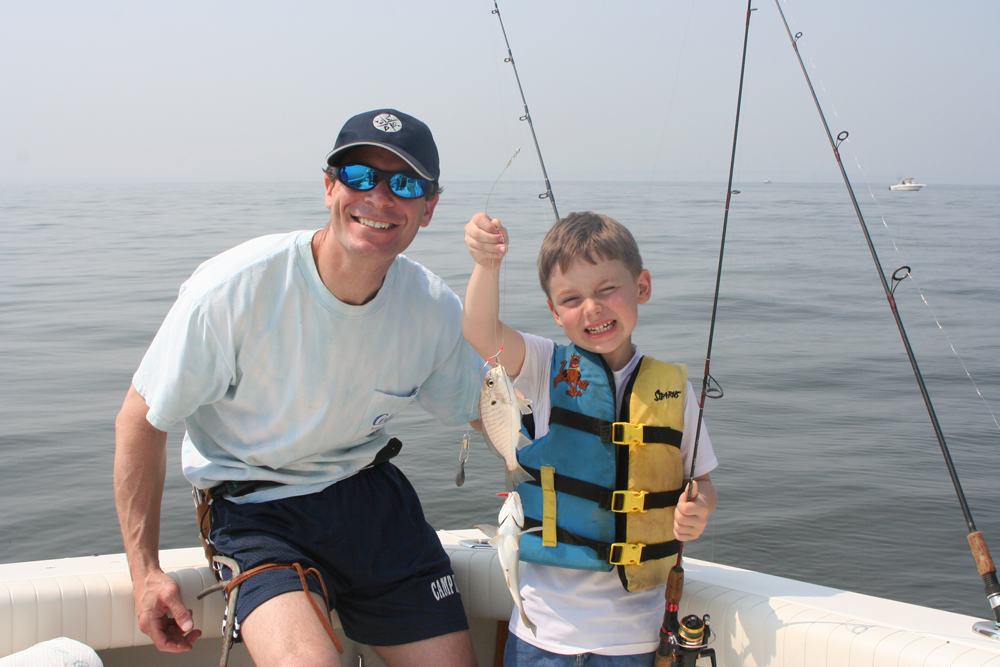
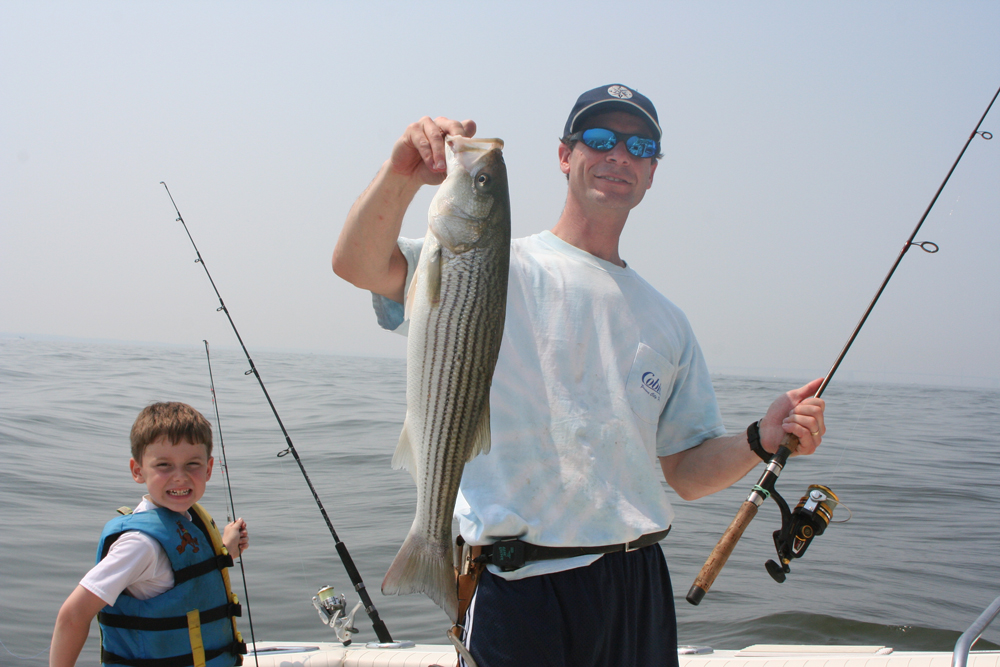
Fishing with live bait is commonly considered one of the most effective techniques used on the Chesapeake, and is employed at one time or another by recreational anglers, charter captains, and just about anyone trying to get a big fish on the end of their line. Since it’s so effective, relatively simple to use, and in some cases (such as bullhead minnow and grass shrimp) is available at most tackle shops, many beginners start out by using live bait. The down-side to using live bait? Once you acquire it, either by purchasing it at the store or catching it yourself, you have to take pains to keep it alive.
Chumming With Ground Fish or Clams
Chumming is the tactic of grinding or mincing a bait, most often fish like bunker or herring but occasionally razor clams or grass shrimp, and then releasing it into the water to attract fish. Most anglers chum from a boat while at anchor, since you want to remain stationary and bring the fish close to you with the scent and free food provided by the chum. Some anglers also chum from shore, however, by broadcasting their chum as far as possible out into the water. In any case a current is necessary for chumming to be effective, or the chum just sinks and doesn’t disburse through the water to bring in fish from afar. You can learn a number of tricks and tips about chumming by reading this article about chumming tricks.
Chumming is extremely effective when fishing for striped bass, bluefish, sharks, and also cobia. In fact, at times it's the very best way to catch cobia and it's the method we employed for our How to Fish For Cobia on Chesapeake Bay video.
Some anglers grind their chum on the spot, but more commonly they will buy pre-ground frozen blocks or buckets of chum. The frozen chum can then be hung from the side of the boat in a net or a bucket with holes, and will disburse slowly as it melts. This can be particularly advantageous as the consistency of a chum slick is even more important for attracting fish than its size or volume. A little bit of chum going into the water slowly but steadily works far better than large amounts that are released haphazardly.
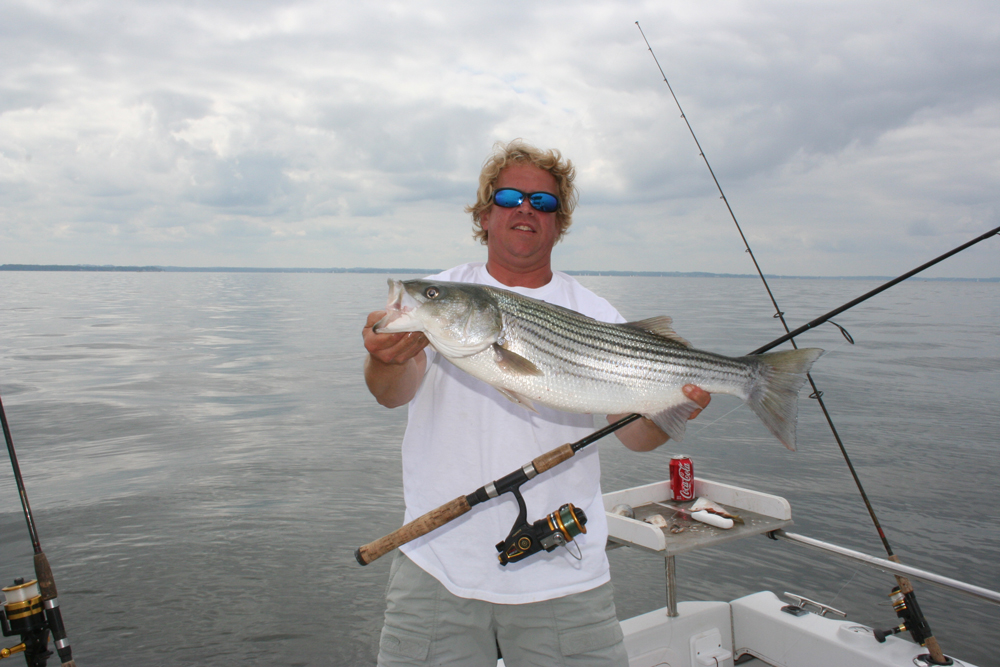
Although chumming is a tactic all its own, it’s used in conjunction with fishing cut bait. In a chum slick of menhaden, for example, the anglers will usually bait their hooks with cut menhaden. If the chum consists of razor clams, the anglers would be baiting with razor clam. Those baits will then be set at differing depths with the use of added weight, until the angler determines the most effective depth to fish at.
Some anglers will also try fishing live baits in their chum, and on occasion, casting lures as well. But as a rule of thumb, the chum and the baits are matched because the fish you’re trying to catch can become quite focused on that particular type of food.
Once again, the main down-side to chumming is the mess it can make on a boat. It also forces the angler to buy additional supplies—the chum or lots of fish for grinding—and it requires constant attention to make sure the flow of chum is constant and sufficient.
Trolling With Lures
Trolling is when lures are set out behind a boat, and the forward motion of the boat pulls them through the water to give them a life-like appearance. Depending on the size and speed of the species being targeted, trollers may set their throttles to move the boat anywhere between two and eight miles per hour. Specific types of lures which can provide their own “action” when moving through the water at these speeds, such as lipped plugs that swim because of water resistance, spoons that wobble as they move through the water, or lures with paddle-tails that wiggle back and forth, are most effective for trolling.
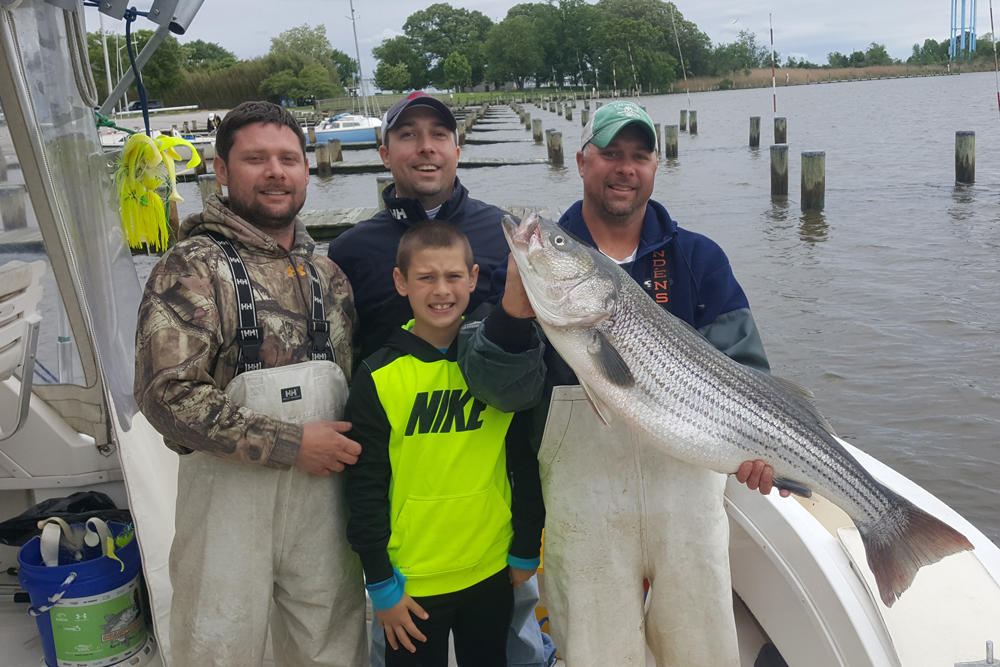
Trolling can be highly effective on just about any open-water fish and in some cases, such as Spanish mackerel, regularly works better than any other technique. Many professional charter boats favor trolling since it allows the captain and mate to regulate the appearance of the lures and how they travel through the water with no additional effort or expertise on the part of their customers. In effect, once the lures are set out behind the boat by the mate, all the angler has to do is reel the fish in after it strikes a lure. Tension already on the line, thanks to the boat’s forward motion, will set the hook all by itself.l Check out this video on how to troll during the fall season on the Bay.
In some areas trolling is the most common method of Chesapeake Bay fishing from a boat and also from fishing kayaks. Many anglers also employ “planer boards” which are tied or cleated to a line, and utilize water-resistance to move out 100’ or more to the side of the boat. Then the angler puts fishing lines on the planer board line, to spread them out and away from the boat. Using this method, some captains may troll two dozen or even more lines at the same time. This used to be the preferred method for trolling for spring trophy striped bass. Today, however, that season has been eliminated in an effort to protect the striped bass spawning stock.
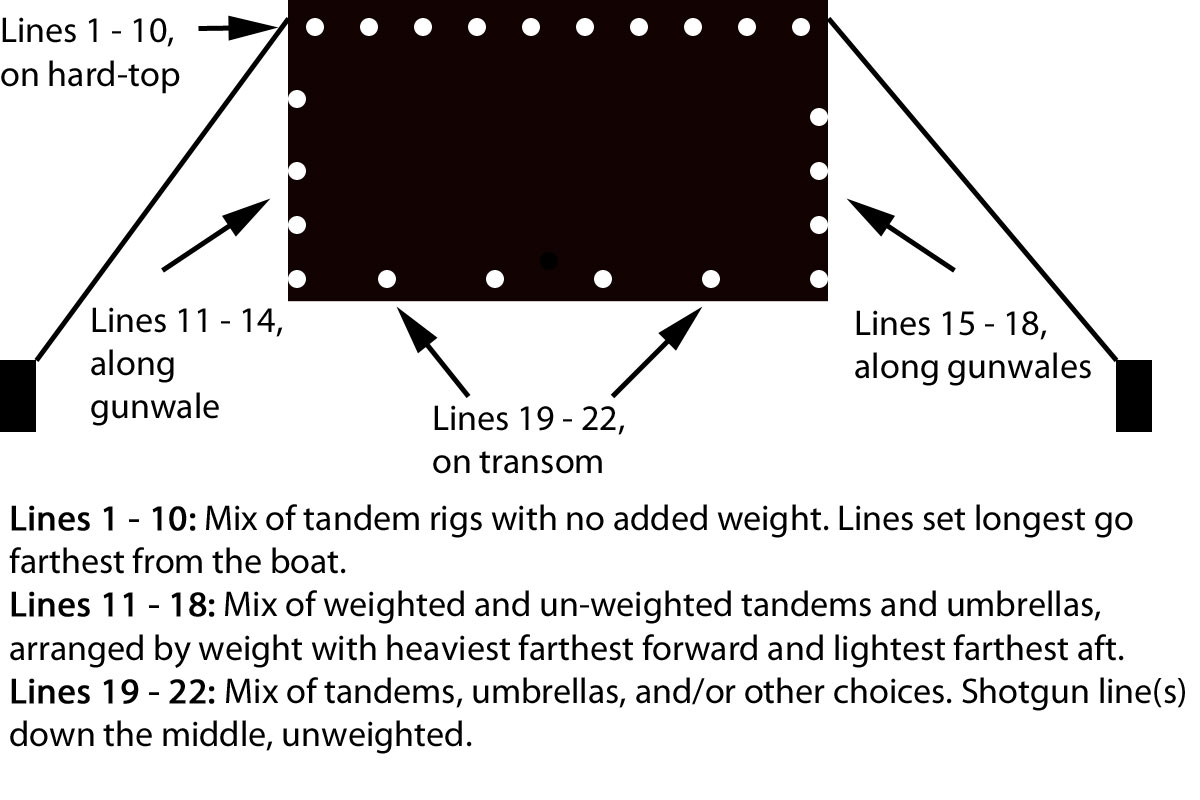
There are many subcategories of trolling styles used by fishermen on the Chesapeake Bay, including:
- Standard trolling, where relatively havy gear and lots of lines are generally employed.
- Light tackle trolling, which is often used in shallow water and/or in tributaries. The only real difference between light tackle trolling and other forms of trolling is that the rods, reels, and lures are commonly much lighter and smaller than those generally used while trolling.
- Kayak trolling, which has grown quite a bit in popularity recently. Thanks to handsfree propulsion systems, it’s possible for a lone kayak angler to tow several lines.
- Pier trolling, where an angler walks down a pier or bulkhead with his line in the water.
- Bottom bouncing, an oldschool tactic where a rig with a heavy weight and a bucktail is jigged as it’s trolled along the bottom.
- Fast trolling, where small spoons are pulled, often on diving planers, specifically to target Spanish mackerel.
Casting and Retrieving Lures
A very popular method among both shoreline and boat anglers is casting and retrieving lures. Since this style of fishing takes constant input from the angler, as opposed to chumming or trolling, it’s favored by people who are looking for a more hands-on experience. It usually takes focus and effort to be successful, requiring the angler to cast accurately, find the best retrieval speeds, “work” the lure to give it a life-like action, and set the hook when a fish strikes.
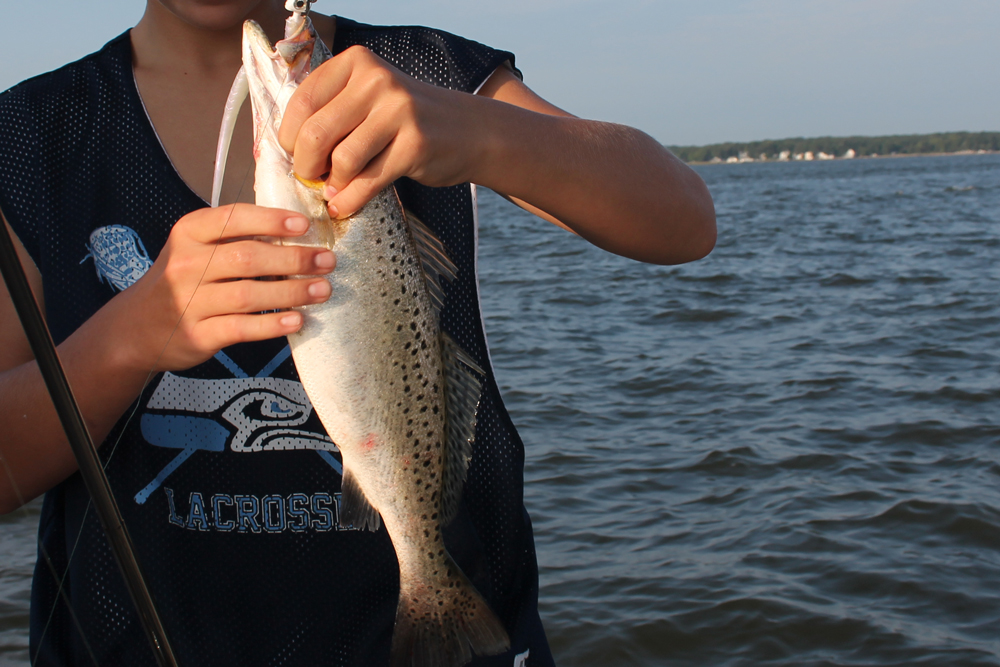
Some common types of cast and retrieve fishing used on the Chesapeake Bay include:
- Topwater, where a plug or popper is “walked” or “chugged” across the surface to mimic an injured baitfish. This style of fishing is sometimes called “walking the dog” and is most effective when fish are feeding right at the surface during daybreak and sunset.
- Casting soft plastic jigs such as Bass Kandy Delights (BKDs) on lead jigheads, which is commonly used to catch fish near structure along a shoreline, or suspended in deeper water.
- Crankbait fishing, where lipped or lipless plugs like Rat-L-Traps, create their own swimming action as they move through the water.
- Sight fishing, when the captain or anglers prowl around and visually look for fish, then toss lures to them.
Casting with lures is also a common and effective way of fishing for many of the freshwater species found in the Chesapeake’s northern reaches, and far up its tributaries. Largemouth bass is the most popular fish commonly targeted in this way, and even though the Bay is a brackish estuary, in certain areas it offers excellent large mouth bass fishing. Anglers will often cast lures more commonly seen in lakes and reservoirs, such as plastic worms and spinnerbaits, to target these game fish.
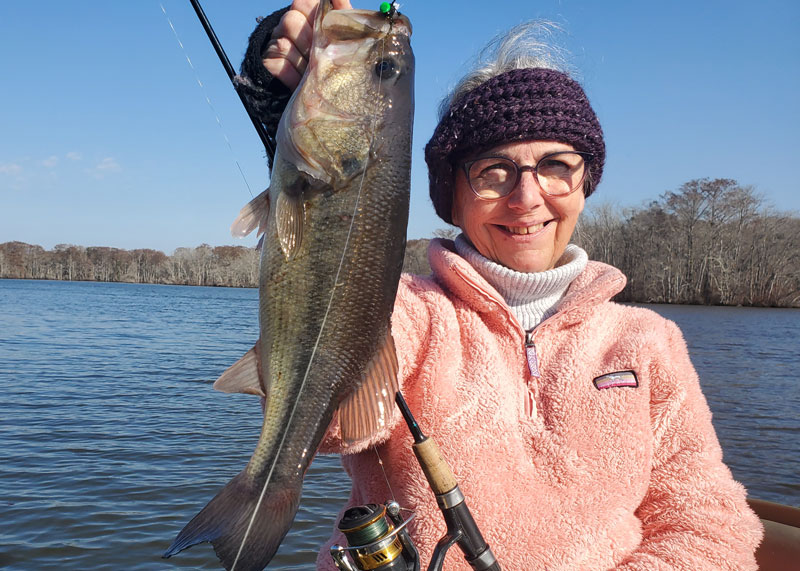
Taking this into account, we see one of the main reasons why the Chesapeake is so famed for its fishing, and belongs on every angler’s bucket list: In the morning a fisherman can target a freshwater species like large mouth bass and experience casting lures in a scenic river setting; then he or she can run down-river and catch saltwater species such as striped bass and flounder; a short run from there this same angler on this very same day can target large oceanic fish like cobia and black drum.
Jigging with Spoons and Soft Plastics
Jigging is a form of fishing employed all across the world, including in the Chesapeake Bay, where a lure or jig is given action by the angler with his or her rod-tip. Most often, the types of lures used for jigging include metal spoons and lead-head jig heads with bucktail hair or soft plastic bodies. Jigging is something of a catch-all name, and actually incorporates a number of very different styles of fishing.
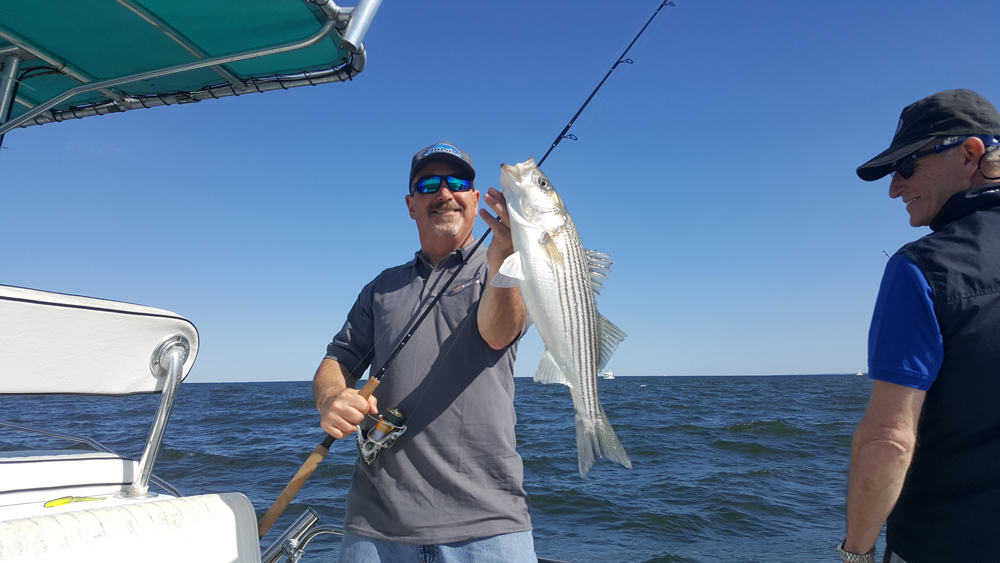
Vertical Jigging
Vertical jigging is one of the most common forms of jigging, and is exactly what it sounds like: the captain positions the boat directly over a school of fish, and anglers drop down their lures, then sweep the rod tip up and down to give a vertical swimming action to them. This technique is often used on schooling fish in relatively deep water, such as weakfish or stripers. In shallower water, some anglers jig vertically with lighter, smaller lures, to catch species like flounder, stripers, and bluefish. We discuss this tactics in detail, in How to Fish for Flounder in DelMarVa Bays and Inlets. Many people also tie tandem rigs for jigging, which allows an angler to experiment with two different offerings at the same time.
Speed Jigging
This term is used to describe dropping a heavy metal spoon to great depths, then retrieving it more or less vertically through the water column at a high rate of speed as the angler works the rod to give the lure an erratic motion. Speed jigging is usually used to trigger a reaction strike from suspended gamefish, which may not be interested in attacking a lure with a more lethargic presentation. We discuss it in detail, in our Speed Jigger’s Primer.
Cast and Retrieve Jigging
Jigging while casting and retrieving is usually attempted with a lead jig head and soft plastic tail, or with a bucktail or similar lure. The lure is cast out and allowed to sink to a particular depth. Then, during the retrieve, the angler gives his or her rod quick twitches and jerks to make the jig appear life-like as it moves through the water.
Meat Jigging
This style of fishing incorporates both lures and bait, together. A jig is “sweetened” with a strip of fish, squid, or other cut bait, and then gets lowered to the depth of the target species. The lure is then jigged up and down, gently enough that the bait doesn’t rip free. This tactic allows anglers who enjoy lure fishing to target species that sometimes really just want to eat bait as opposed to lures, like black sea bass.
Yo-Yo Jigging
This is about the simplest form of jigging there is. An angler drops the lure down deep, then cranks it up as fast as possible. Like speed jigging, this will sometimes activate fish that are ignoring slow-moving offerings.
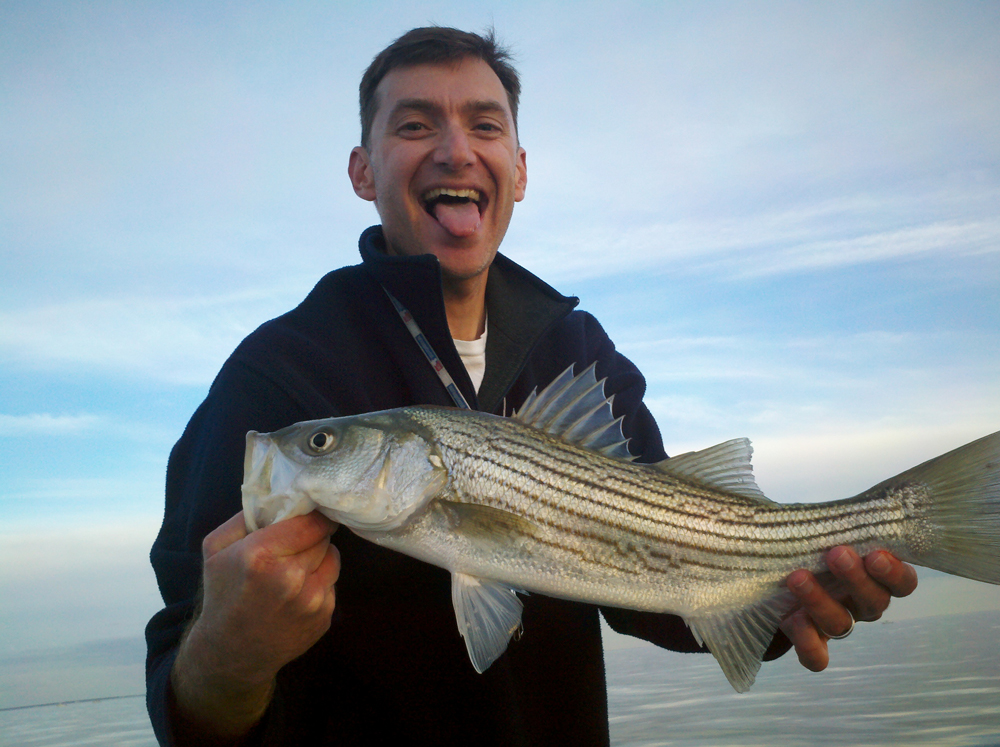
You can get loads of information on all varieties of jigging by reading the book Rudow's Guide to Modern Jigging. Also check out our video on jigging gear.
And our video on light tackle jigging tips, which we shot with the guys from Anglers Sport Center.
What all of these different tactics and techniques have in common, of course, is that they’re used by recreational anglers to catch fish in the Chesapeake Bay. Read FishTalk magazine and peruse our web site to learn more about how to be successful when you go Chesapeake Bay fishing, as well as when you go fishing anywhere in the entire Mid-Atlantic region. And don't forget to Sign up here to get the weekly FishTalk Chesapeake Bay and Mid-Atlantic fishing reports in your email inbox, every Friday by noon. Our fishing reports editor Dillon Waters does an excellent job of gathering the latest angling intel each and every week, and we bring you this service free of charge so hopefully, the next time you hit the Bay you'll catch more, bigger fish!
Editor's note: This article was originally published in May of 2017 and was last updated in March of 2025.